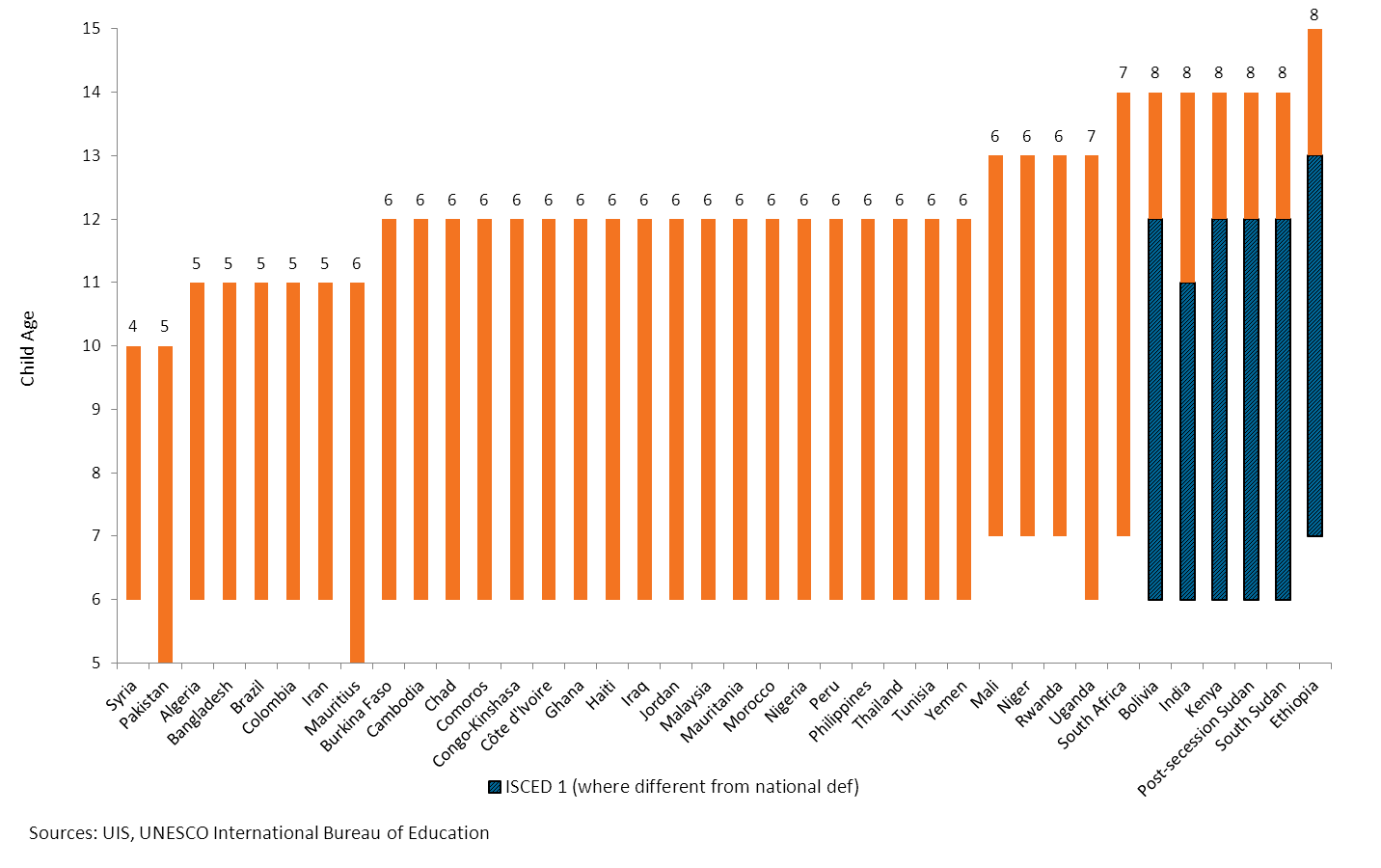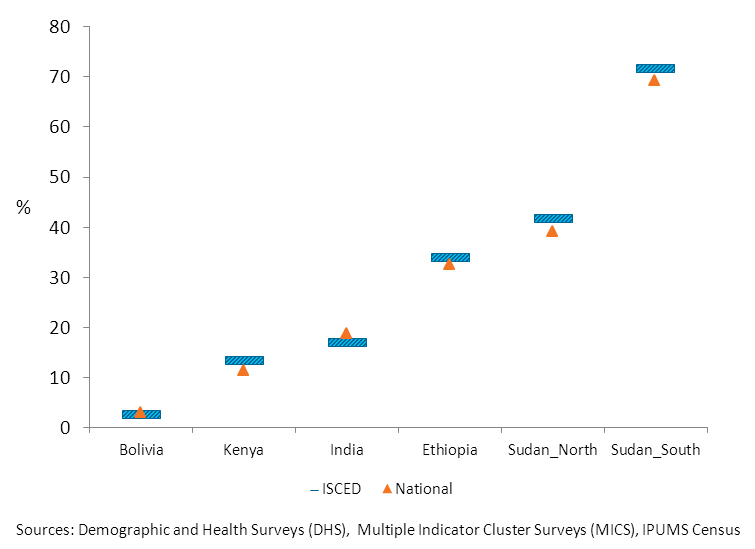You are here
What Constitutes Primary Education?
Starting Ages and Durations of Primary
Determining the extent of the out of school issue involves working with malleable definitions of the primary education cycle and different measures of school participation that vary by data source. These factors produce significant variations in estimates of out of school children. For example, 2011 estimates of out of school children of primary school age in Ethiopia range from 1,702,685 or 13% (using UIS administrative figures and an ISCED[1] definition of primary) to an even more dramatic 6,568,619 or 32% (using household survey data and Ethiopia’s national definition of primary). These disparate estimates seem to raise more questions than answers about the extent of school participation.
What constitutes primary education is subject to interpretation, and cross-country variation exists around the starting age for primary enrollment, as well as the duration of the primary schooling cycle. As a result, countries with longer duration of primary education cycle are naturally contributing proportionately higher numbers to the global out of school children estimate than they would, had they set primary cycles shorter. Most notably, however, differences exist between the definitions of primary education established by national Ministries of Education and the internationally set definitions set by UNESCO’s International Standard Classification of Education (ISCED). Whereas national definitions privilege local over international understandings of primary education, ISCED “translates” diverse national school cycles into internationally standardized levels (e.g. ISCED 1 for primary education), in some cases resulting in diverging estimates of the primary school-aged population.
Length of primary education according to national definitions and ISCED definitions.
Duration of the national cycle is labeled above each bar.
 The figure to the left displays the theoretical starting ages and durations of primary education cycle for 38 countries according to national definitions and, where different, ISCED definitions. The national definitions of primary have entry ages from five to seven with an average starting age of six years and durations of primary from four years to eight years with an average duration of six years. ISCED-1entry ages align with national ages; however, ISCED-1 durations range from four to only seven years. ISCED always revises eight-year national primary cycles downwards[2]; the general pattern is for ISCED to preserve national definitions of primary except where they are prolonged.
The figure to the left displays the theoretical starting ages and durations of primary education cycle for 38 countries according to national definitions and, where different, ISCED definitions. The national definitions of primary have entry ages from five to seven with an average starting age of six years and durations of primary from four years to eight years with an average duration of six years. ISCED-1entry ages align with national ages; however, ISCED-1 durations range from four to only seven years. ISCED always revises eight-year national primary cycles downwards[2]; the general pattern is for ISCED to preserve national definitions of primary except where they are prolonged.
Indeed, it is the six countries with comparatively longer national primary durations - eight years—Bolivia, Ethiopia, India, and Kenya, Sudan (post-secession), and South Sudan[3]—that have different ISCED-1 durations. For Bolivia, Kenya, Ethiopia, Sudan, and South Sudan, the ISCED-1 estimate is six years, two years shorter than the national definition. For India, ISCED defines a five-year primary cycle, which aligns with the national definition of lower primary though the complete national definition of elementary education includes an additional three years of upper primary. This means that ISCED definitions fail to mark the critical transition from primary to secondary education, a feature of which is often a primary examination and certificate. Furthermore, as a result of the truncation of the primary cycle, ISCED-based estimates of out of school children are substantially lower in such countries in comparison to national definitions. The impact of these definitional differences on numbers of out of school children for countries is most dramatic in populous countries— such as India and Ethiopia, which had 2010 national populations of 1.2 billion and 83 million respectively according to the United Nations Population Division (UNPD, 2011). In such countries, the expansion of age brackets may add millions to the national count of out of school children.
Comparison of out of school (%) of primary age by ISCED and national definitions of primary
 Adherence to national definitions of primary also yields varied rates of out of school children, which may be higher or lower depending on pupil flows in an education system. As the figure to the right demonstrates, rates of out of school children shifted up or down by between 0.5% (Bolivia) and 2.6% (Post-secession Sudan) according to different definitions. In four of the six countries with shorter primary school cycles according to ISCED than according to the national definitions(Ethiopia, Kenya, South Sudan, and Post-secession Sudan), the longer national definition of primary resulted in a lower percentage of out of school children.
Adherence to national definitions of primary also yields varied rates of out of school children, which may be higher or lower depending on pupil flows in an education system. As the figure to the right demonstrates, rates of out of school children shifted up or down by between 0.5% (Bolivia) and 2.6% (Post-secession Sudan) according to different definitions. In four of the six countries with shorter primary school cycles according to ISCED than according to the national definitions(Ethiopia, Kenya, South Sudan, and Post-secession Sudan), the longer national definition of primary resulted in a lower percentage of out of school children.
[1] UNESCO’s International Standard Classification of Education or ISCED helps classify education levels for purposes of cross-national comparison. Throughout the paper, ISCED refers to the ISCED 1997 classifications that were still in use at the time of writing.
[2]Ireland, which retains its eight year primary cycle in the ISCED 1997 classification and is not revised downwards, is an exception.
[3] The 2008 IPUMS dataset for pre-secession Sudan has been used with the territories associated with post-secession Sudan and South Sudan.

Add new comment